PANDORA’S BOX
The diatoms of Sullivant & Wormley 1859
Frithjof A.S. Sterrenburg
By the mid-19th century, microscope optics had become capable of resolving striae and puncta (“dots”) in many diatoms and in 1859 two American microscopists, Messrs Sullivant and Wormley (reference) wrote a nice paper on measuring stria density. In this article, they described three new species of “Pleurosigma” from the Scioto River, Columbus, Ohio, USA: Pleurosigma sciotoense, P. obtusatum and P. wormley. Probably because their paper was published in a journal that was not widely circulated, certainly not among European diatomists, these species were largely neglected thereafter. They received a few cursory remarks, but Boyer (reference) was the first to publish new descriptions, provide photomicrographs and make one selected slide of a single specimen of each of these diatoms. All three species were transferred to the genus Gyrosigma, as they show 2-system (transverse and longitudinal) striation, not the transverse and 2 oblique systems of the genus Pleurosigma as defined by Cleve. Finally, Reimer in Patrick & Reimer (reference) included them in their diatom flora of the United States. However, these subsequent studies were still restricted to the original materials, which are kept in the collections of the Academy of Natural Sciences of Philadelphia, and the identity of these diatoms was rather uncertain.
The challenge
In the early Nineties, I had become intrigued by this sparsity of information and concluded that there were two possible reasons:
-
These species are very rare and perhaps even limited to (an area of) the USA, or:
-
They have been found elsewhere but were subsequently described under different names.
In the former case, this would be a highly interesting example of no less than three “endemic” species, organisms that for some (ecological?) reason are limited to a circumscribed geographic area. In the latter case, these subsequent names would be synonyms, not to be used for identification. I decided to face that challenge, a decision that led to toil, trouble, and eventually: triumph. The formal scientific description of this study was presented in Sterrenburg 1994, but the sleuthing involved may be interesting also for the general microscopist.
Sleuthing
First of all, I contacted the late Dr. Charles Reimer of the Academy in Philadelphia, asking for the loan of the slides made by Boyer. These were to be formally designated as the “type slides”, see later on. I received three slides, which immediately dampened my enthusiasm: they were mounted in Canada Balsam so contrast was miserable. Differential interference contrast was indicated, but this was found to be impossible: the slides were very thick and the DIC condenser could not be made to focus correctly. The same was true for the condensers of the various phase-contrast sets I had, so in the end I concocted a special phase-contrast condenser with a long working-distance but still permitting illumination of the fairly large (mean N.A. = 0.75) phase-annulus of a Leitz phase-contrast objective with N.A. = 1.3. By this means, useful images could be recorded, as shown for the three species in Figs. 1- 2. These are 6 Mb scans of my old negatives on Kodak 2415 film; there is a slight loss of detail but on the other hand, digital processing permits easy adjustment of the tonal range. However, phase-contrast causes “glare” in the more thickly silicified terminal areas and central area of the valves, where important detail such as the raphe fissures becomes masked.
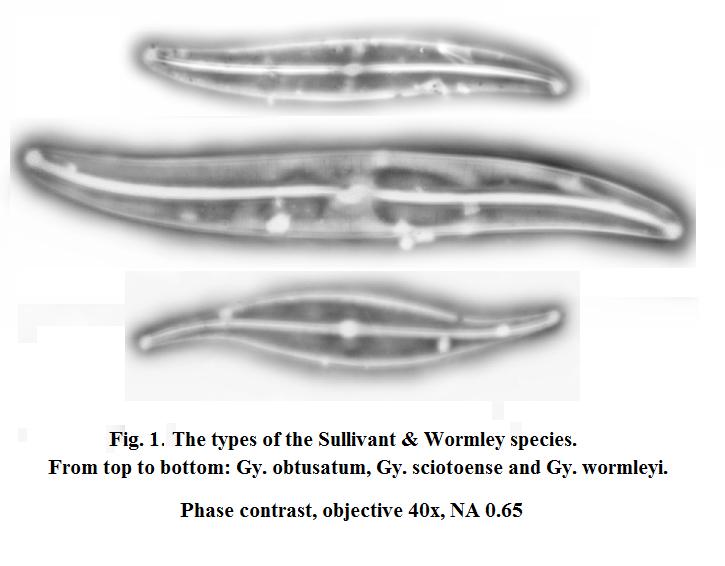
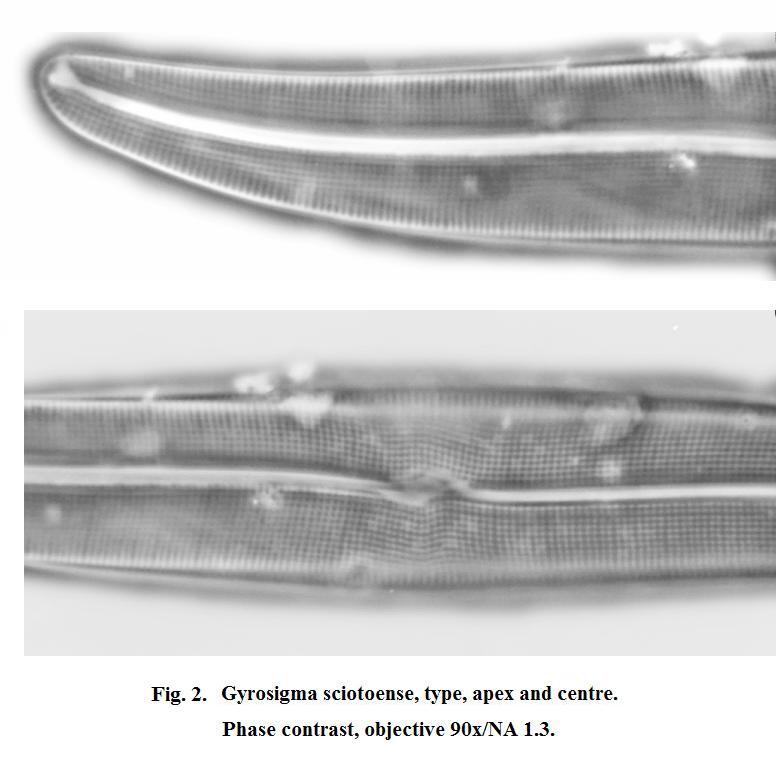
So my next request was for a sample of the original material – should this still be extant – to make better quality slides. Also, I now strongly suspected there were 3 flies in the Sullivant & Wormley ointment and to prove this, I needed to examine these diatoms in SEM.
Eureka!
Charley Reimer graciously sent a very small quantity of the original material, and I could make just one preparation (a 10 mm diameter coverslip, unmounted, because it was to be used for SEM), with some trepidation because of the rarity and ancient provenance of the stuff. Lo and behold, there were diatoms present! But lo and behold again: not a single Gyrosigma… Fearing that Charley Reimer would by now be thoroughly fed up with me – after all, I might be a bumbling oaf for all he knew – I asked whether he could send an additional sample? And then he sent me the original small phial, writing “this is all there’s left, only the tube is empty as far as I can see…”
Indeed the situation appeared to be hopeless: all I could discern with a 20x magnifier was some minute fly-specks on the wall of the little glass tube. This could hardly be regarded as a sample… I nevertheless added two drops of hydrogen peroxide to the tube, let it stand in bright sunlight for 2 days to detach the diatoms that might be present, and made another preparation on a piece of mica, which I examined dry under the light-microscope to see whether there was anything present. I then discovered that incredibly, I had retrieved 2 specimens of each of the Sullivant & Wormley species, one each presenting its internal and one each presenting its external valve face – an ideal situation. Small fragments of the mica bearing these specimens were then snipped off, mounted onto stubs and sputter-coated with 20 nm gold for the SEM. Some of the SEM pictures are presented here as Figs 3 – 5 .
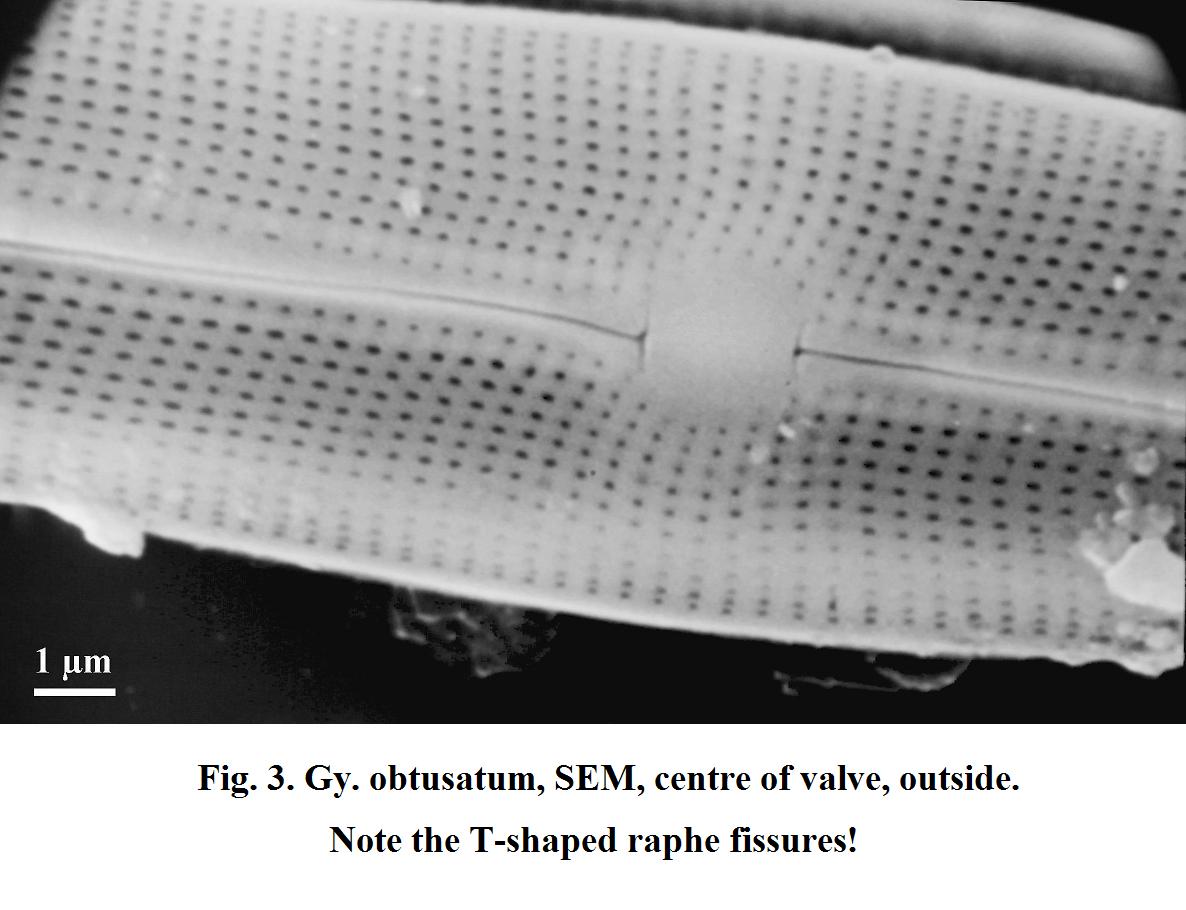
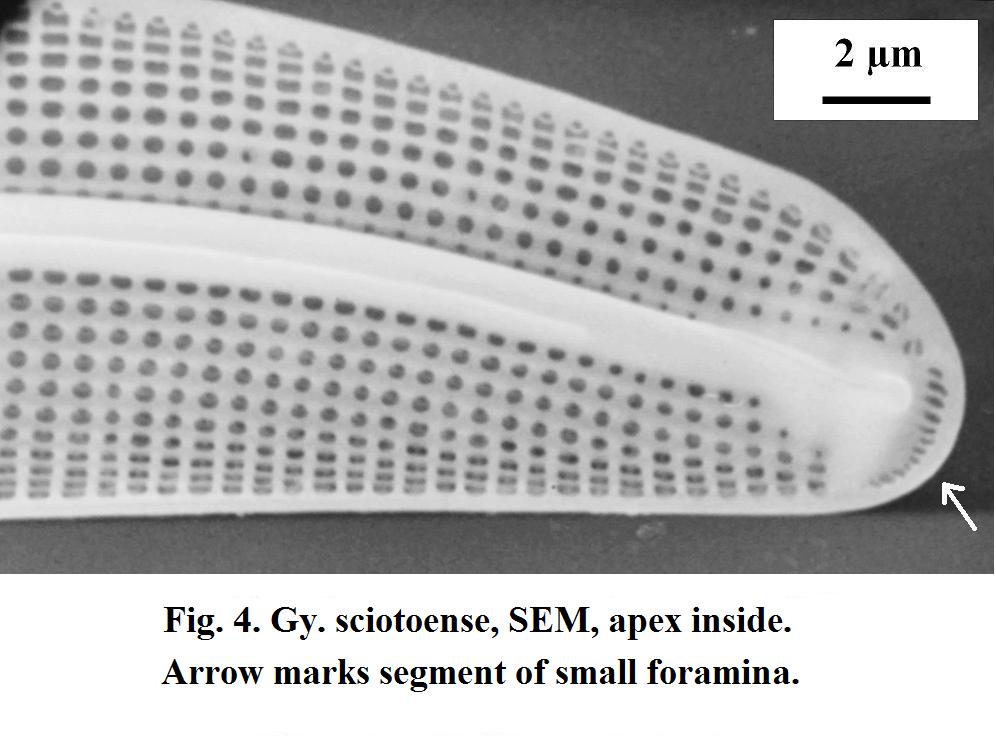
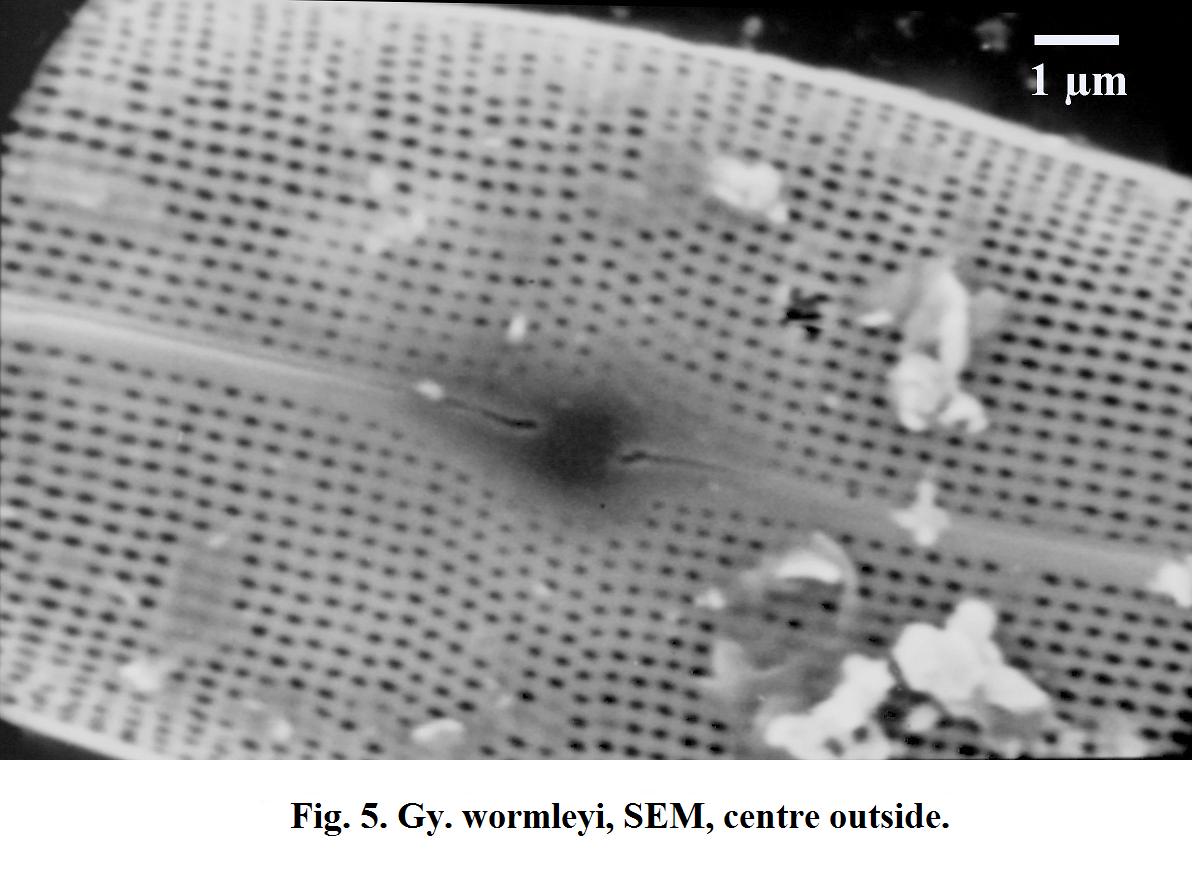
The conclusions
The case was solved: all three diatoms had been described later, under different names, as follow:
Gy. sciotoense (Sullivant & Wormley 1859) Cleve 1894 has been subsequently and incorrectly named “Gy. spenceri var. nodiferum” (Grunow) Cleve and “Gy. nodiferum” (Grunow) Reimer. It is a species of fresh to slightly brackish waters, common in Europe (very common in Dutch waters especially) and the USA and probably cosmopolitic.
Gy. obtusatum (Sullivant & Wormley 1859) Boyer 1922 has been subsequently and incorrectly named “Gy. scalproides” (Rabenhorst) Cleve. A freshwater species, somewhat less common than the previous and personally seen in Europe and the USA.
Gy. wormleyi (Sullivant 1859) Boyer 1922 has been subsequently and incorrectly named “Gy. parkeri” and “Gy. distortum var. parkeri” – as also suggested by Reimer in Patrick & Reimer, but then not proven in SEM. A species of fresh and somewhat brackish waters, which at that time I had only seen in small numbers in a few samples from Holland, Germany and Hungary (Lake Balaton).
The Sullivant & Wormley species had thereby been typified (in Boyer’s slides) and restored to their rightful place in diatom taxonomy. The later names may have been more commonly used (because of neglect of the original and subsequent publications) but are to be discontinued – as they have been in the recent freshwater flora by Hofmann, Werum and Lange-Bertalot (references). But that was not all…
Pandora in action
In the first place, to prove that the species described under the later synonyms were indeed identical with the Sullivant & Wormley diatoms, I had also examined the type materials of “Gy. scalproides” and “Gy. spenceri var. nodiferum”.
Secondly, because Gy. sciotoense had been named a “variety” of Gy. spenceri, it became necessary to examine the latter. I had long suspected the very commonly described Gy. spenceri because no description in the literature appeared to contain a single essential difference from the equally common Gy. acuminatum. That became a separate paper, published a year later (references) and showing that for 150 years, uncritical repetition of previous publications had maintained the spurious species “Gy. spenceri” – which is indeed a later synonym of Gy. acuminatum. Even the most common freshwater diatom species had been confused for more than a century, and it took me a couple of months to believe my own findings! As “Gy. spenceri” had also been claimed to occur in brackish to marine waters, two subsequent papers dealing with 3 additional species were required to clear up that confusion.
Thirdly, “Gy. parkeri” (the synonym of Gy. wormleyi) had been described from marine samples, it had been called a “variety” of Gy. distortum (W. Smith) Cleve, and Hustedt 1930 (references) claimed to have found the latter species (a fully marine diatom) in freshwater. So I obtained type material of Gy. distortum from Dr. David Williams (Natural History Museum London) and the sample Hustedt referred to from Friedel Hinz (Hustedt Arbeitsplatz, Bremerhaven, Germany). It then became evident that Gy. wormleyi was very different from Gy. distortum and that Hustedt actually had the former species, not the latter…
But a few years later (Sterrenburg et al. 2000), two colleagues and I discovered thriving populations of what we verified (SEM) was Gy. wormleyi in the Salton Sea, California, USA. This was originally a freshwater lake, which in the course of a century has become extremely salty. Apparently, the organism had gradually adapted to the changing environment – an exceptional phenomenon!
Finally, Reimer in Patrick & Reimer described “Gy. nodiferum” (= Gy. sciotoense), but from the excellent drawing supplied I concluded that this was not that species! So I sent Charley Reimer yet another request for original material and in both the LM and SEM it became immediately clear that this was indeed a new species, which I named Gy. reimeri, of course. So far, I have only seen it in several samples from the Southern States of the USA, but it may be more widespread and may simply have been overlooked (Fig. 6 and 7).
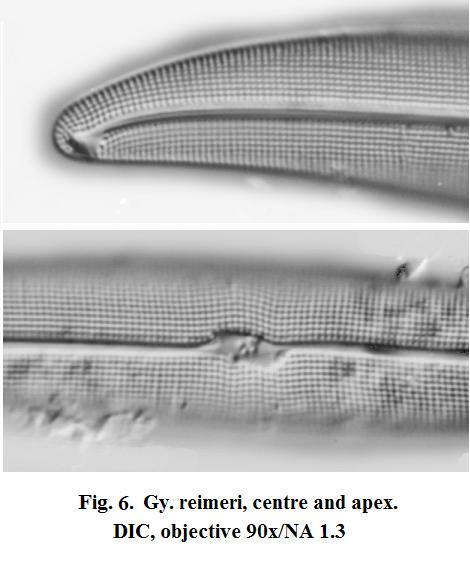
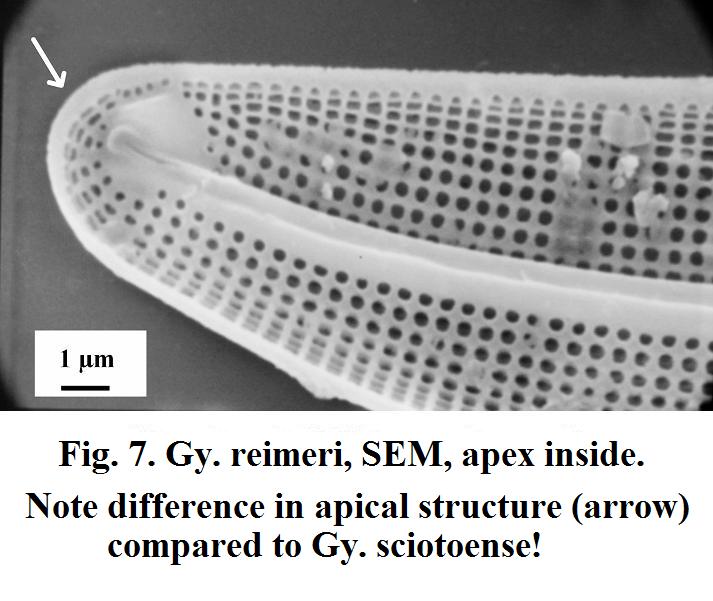
Taxonomy,what’s the use?
So what’s the use of this sleuthing, which started with 3 obscure taxa and escalated to about a dozen differently named diatoms? Of course it was great fun and kept me off the streets and out of the pubs, but does it have any practical significance?
In the pseudo-progressive Sixties and Seventies, it became fashionable to regard taxonomy as a Daddy Longlegs activity, on the same intellectual level as stamp collecting. Like so many “progressive” ideas, this is pure drivel, of course. If you have false notions of the entities you are discussing, the discussion will make no sense. If “off the cuff” you claim a freshwater ecology for a strictly marine species (Hustedt’s “Gy. distortum”) you’re not to be taken seriously. And if you talk about species diversity – a topic at present – you should first remove false species (“Gy. spenceri”) and include overlooked species (Gy. reimeri) before you can draw useful conclusions. I have so far observed about 3 times as many different Gyrosigma and Pleurosigma species in The Netherlands than had ever been recorded, so the species diversity in these genera has been multiplied by three for the country…
Taxonomy is not stamp collecting, but (re)defining the biological individuality of the taxa (“names”) described. This can only be done reliably if you examine the original materials to define an unequivocal standard of reference (the “type”) and this shows the great value of Museum collections and the stalwarts who look after them!
At the time of writing, I am uploading all my data on Gyrosigma and Pleurosigma on several websites and full descriptions and further images of the diatoms discussed here can be found on AlgaeBase, for instance.
Comments to Frithjof Sterrenburg are welcomed.
References:
Boyer, C.S. (1922). New and rare species of diatomaceae. Contributions from the Biological and Microscopical Section of The Academy of Natural Sciences of Philadelphia, Nr. 1, July 15, 1922, p. 18, Pl. IV
Hofmann, G., M. Werum and H. Lange-Bertalot (2011). Diatomeen im Süßwasser Benthos von Mitteleuropa. Gantner Verlag, pp. 908, pl. 133.
Hustedt, F. (1930). Bacillariophyta. In: Pascher, Süsswasserflora vonMitteleuropa. Heft 10, 1-466. Jena
Patrick, R. and Ch. Reimer (1966). The diatoms of the United States, exclusive of Alaska and Hawaii. 1. Monograph, Academy of natural Sciences of Philadelphia 13, p 688
Sterrenburg, F.A.S. (1994). Studies on the genera Gyrosigma and Pleurosigma (Bacillariophyceae). The species of Sullivant & Wormley 1859, synonymy and differentiation from other Gyrosigma taxa. Proceedings Academy of Natural Sciences of Philadelphia, 145, 217-236. NOTE: subtitle inadvertently omitted in print.
Sterrenburg, F.A.S. (1995). Studies on the genera Gyrosigma and Pleurosigma (Bacillariophyceae). Gyrosigma acuminatum (Kützing) Rabenhorst, G. spenceri (Quekett) Griffith et Henfrey and G. rautenbachiae Cholnoky. Proceedings Academy of Natural Sciences of Philadelphia, 146, 467-480
Sterrenburg, F.A.S., M.A. Tiffany and C. Lange (2000). Studies on the genera Gyrosigma and Pleurosigma (Bacillariophyceae). Species from the Salton Sea, California, USA. Proceedings Academy of Natural Sciences of Philadelphia, 150, 305-313
Sullivant, W.S. & T.G. Wormley (1859). On the measurement of the striae in diatoms. American Journal of Science and Arts 27: 249-252.